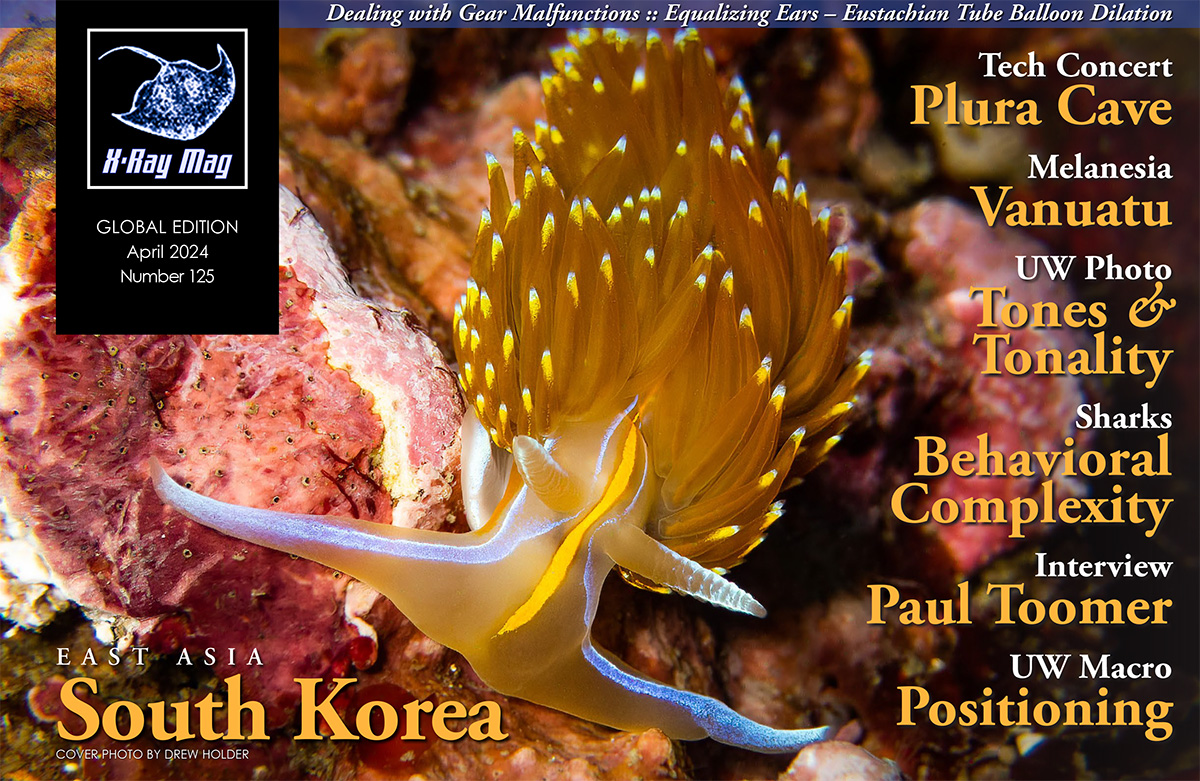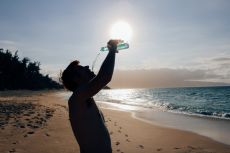We asked our contributors to share their favorite underwater photos that showcase tones and tonality, and they returned with a range of wide-angle and macro shots featuring a variety of marine life, reefs and topography.
Contributed by
(To see all the images in this article, please scroll down to the end and download the PDF.)
Here, X-Ray Mag contributors share their chosen images from the cenotes of Mexico to the tropical waters of the Marshall Islands, Chuuk Lagoon, Palau, the Philippines, Indonesia, Malaysia and the Maldives to the subtropical and temperate waters of New Zealand, South Africa and the US East Coast.
Subtle to Vibrant
Text and photos by Scott Bennett
Malaysia’s Sipadan Island is renowned for its massive numbers of schooling fish. Upon discovering the bigeye jacks at Barracuda Point, I wanted an image of the fish filling the frame. Approaching as slowly as possible, I set both strobes to half power to avoid overexposure. After firing off several shots, I found a composition where the layers of moving fish created distinctive foreground and background elements. The shimmering fish contrasted sharply with the water, generating a study in blue and silver. To accentuate the cool tones, I used the Cool Ocean preset filter in ON1 Effects software with some additional sharpening added.
The cenotes of Mexico’s Yucatan Peninsula had long been on my diving bucket list, and they did not disappoint! The striking geological features combined with gin-clear visibility created a myriad of photo opportunities. However, some of my favourite images were created in the pools where one entered the water. Here, sunlight filtered through the tropical vegetation above, creating ethereal beams of light that pierced the shallows. With the camera pointed upwards, my 15mm lenses captured both the dancing rays and the ripples on the surface above. The entire scene was rendered in hues of green, with the concentric surface patterns contrasting sharply with the richly textured rock. Effects in Adobe Camera RAW were used to enhance the texture, with additional sharpening applied using Topaz software.
The Poor Knights Islands of New Zealand are one of my all-time favourite dive destinations, with a beguiling fusion of temperate and subtropical species. Despite the lack of large corals, every surface is ablaze with colour. Tiny jewel anemones proved particularly photogenic, creating elaborate patchworks encompassing the sheer rock faces. After taking a few wide shots, I decided to move in closer, allowing the vibrant reds and magentas to dominate the frame. A sliver of blue at the bottom left and a lone sea urchin provided some contrast. To enhance the surreal effect, I used the Cinema preset in ON1 Effects software before finishing with some additional sharpening and texture adjustments in Adobe Camera Raw.
Palau’s Jellyfish Lake is a truly unique destination that comes with a plethora of photographic challenges. I had first visited 15 years ago with a Nikonos V camera, but the images were less than triumphant. Now armed with a digital SLR, I was eager for another opportunity. After getting some wide-angle images, I wanted to capture a close-up of a single jellyfish at the surface with the sky behind it. With my freediving skills woefully lacking, this quickly proved easier said than done. I devised a solution by positioning my camera directly beneath the jellyfish and pointing upwards. I used two strobes to illuminate the underside to balance with the ambient light from the sky above. The orange/yellow of the jellyfish provided an interesting contrast to the blue sky. To emphasize the effect, I used the Colour Grade preset filter in ON1 Effects. See more of my stories and photos here.

Enhancing Tones
Text and photos by John A. Ares
The tones in the images that we capture can be rendered as pleasingly as we saw them on the dive, or they may need to be enhanced to convey the feeling that we had when we photographed the scene.
The hard-hat diver in Photo 1 was photographed as part of a “History of Diving” event in a lake in Pennsylvania. Given the historical nature of the dive gear, it was natural that the image would be sepia toned. The color was applied using Nik Silver Efex Pro software. Under Toning in the Finishing Adjustments panel, the Sepia option was selected and adjusted to achieve the desired effect.
Sometimes, a photo taken with available light and a blue background does not represent the scene as we saw it or the feeling we had when we photographed it. The photo of the whale sharks in Photo 2 begged for a cyanotype treatment to enhance it. Again, using the Nik Silver Efex Pro plug-in, the Cyanotype option under Toning in the Finishing Adjustments panel was applied, using the slider to adjust the image.
Most of the time, we try to produce photos that are colorful and fully saturated. The colors illustrate what we find attractive underwater. Rarely on reefs do we find subtlety among certain colors. The mostly white-tinted bubble coral in Photo 3 did not benefit from being turned into a purely black-and-white image. The subtle tones of the white and off-white areas, along with the small splash of color from the shrimp, made for an effect that would have been ruined by heavier treatments in post-production. Visit: JohnAres.com

Shark Triptych
Text and photos by Sheryl Checkman
During a late afternoon nurse shark dive at Dhiggiri Island in Vaavu Atoll on my recent trip to the Maldives, I knelt on the sandy bottom and watched as dozens of tawny nurse sharks swam above and beside me. There was one particular shark that swam directly above me, baring its mouth full of teeth in what looked like a grin in anticipation of an easy snack. I chose this shark portrait for my tonal exploration because of its unusual perspective and Warhol-esque feel.
To get these effects, I first adjusted the exposure, highlights and shadows in Lightroom, then brought the photo into Nik Collection’s Color Efex Pro 4 software, where I was able to play around with the various color variations seen here. Each version gives both the shark and the photo a very different look, from the warm, vintage-looking sepia version to the more pop, poster-like versions in color. Visit: Instagram.com/SherylCheckman
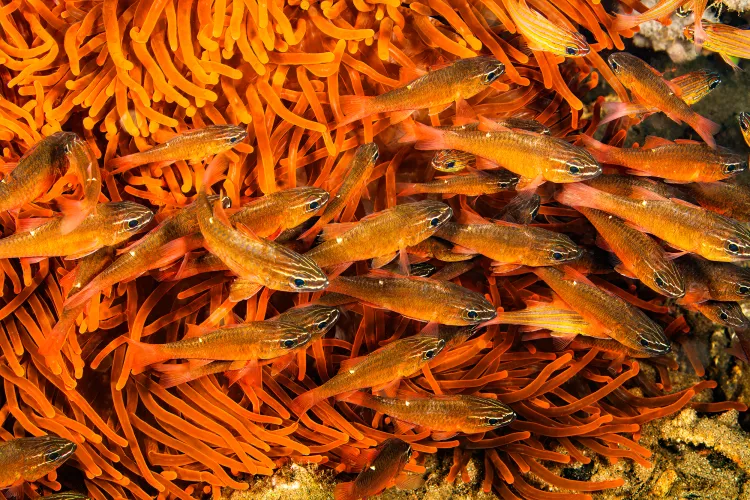
Cool and Warm Tones
Text and photos by Anita George-Ares, PhD
Boo Windows is a famous dive site off Boo Island in South Raja Ampat, Indonesia. The Windows are large openings in a rock formation that extends from the surface down to the reef. We were warned not to swim through the Windows during our dive as there was a strong current on the other side. The Windows were lit only by my video light and sunlight. The resulting low-key image has cool blue tones (Photo 1).
Warm, orange tones predominate the subjects and backgrounds in Photos 2 and 3. The male tomato anemonefish in Photo 2 has a reddish orange body. The anemone tentacles that surround the fish have a brownish-orange tone.
The majority of cardinalfish in Photo 3 are Moluccan cardinalfish, easily identified by the white spot behind the dorsal fin. A few Wassinki and yellow-striped cardinalfish are present in the right half of the image. The Moluccan cardinalfish have brownish-orange bodies with reddish-orange fins. The anemone tentacles are reddish orange except for the yellowish-orange tentacles in the upper left corner of the image. Visit: facebook.com/profile.php?id=100016947967639

Mastering Tones and Tonality
Text and photos by Kate Jonker
In the world of underwater photography, mastering tones and tonality can elevate your underwater images from ordinary photographs to extraordinary works of art. It is the key to captivating underwater photography.
Tones are related to the distribution of light and dark areas in a photograph, while tonality encompasses the range of these tones as different hues and how they blend together.
Beneath the surface, light behaves in its own unique way, creating different tones. Water acts as a natural filter, and the quality and clarity of light is influenced by how calm and clear the water is. By carefully observing how light in the water interacts with your subject and its surroundings, you can manipulate shadows and highlights to create compelling contrasts and depth.
To master tonality, you need to be aware of the colours and their hues within your underwater world. Using rich or contrasting hues can enhance the mood and assist with storytelling within your images. Whether you are capturing the bright colours of a coral reef or the dark depths of the ocean, the use of tones and tonality can breathe life into your underwater images. Visit: katejonker.com
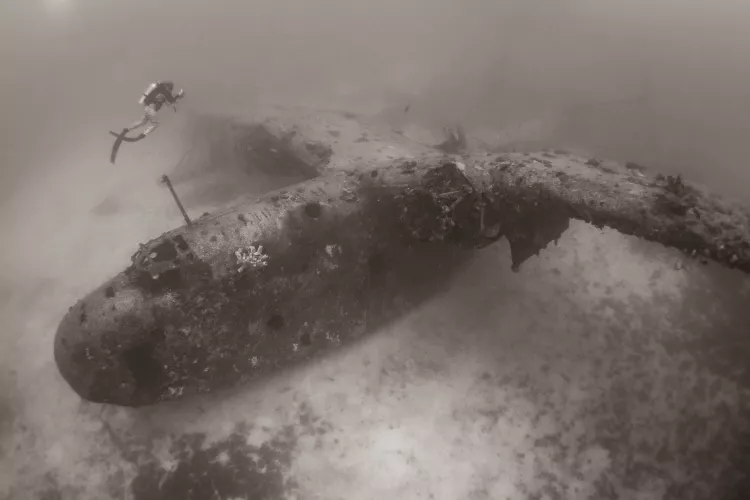
Tropical Wrecks
Text and photos by Brandi Mueller
The topic of tones and tonality got me excited to go back and revamp some older images of my favorite subject: underwater airplanes. Shooting tropical wrecks in color is one way to show the vibrant marine life that covers the wrecks, such as the Aichi E13A “Jake” airplane, encrusted with red sponges and swarming with glittering fish.
But sometimes wide-angle images of large objects end up very blue, with little definition. To overcome this, I often convert wrecks, particularly WWII wrecks, to black and white to add contrast within the image and to give the viewer a sense of age and the passage of time.
It was a really fun challenge to take things a few steps further and convert an image of a massive Martin PBM Mariner to sepia in an attempt to show the aging process of time. I also find it fascinating that the sepia pigment comes from cuttlefish ink, so it seems fitting for underwater images.
For the image of a Nakajima C6N “Myrt,” I played around with negative inversions, taking the black-and-white image and converting it to a negative, but with a bit of blue hue left behind. Visit: brandiunderwater.com
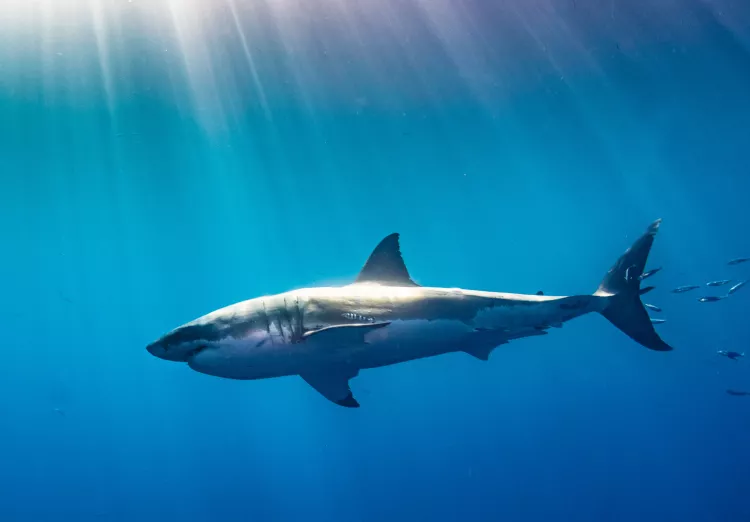
Changing Tones
Text and photos by Gary Rose, MD
Much of the fun of underwater photography is in the post-processing. Just like with any form of art, the touch-ups, additions, deletions, and tonal changes can alter the entire photographic expression. A mood can be set, ambience softened, light hardened. The choices are infinite. With the use of a single photo, I will demonstrate.
Photo 1 is an average photo of a great white shark taken at Guadalupe Island, Mexico. The photo is hazy and has a somewhat flat quality. The viewer can easily see a potential to sharpen this up and highlight the background cathedral lighting, as well as spotlight the fabulous glow of the midday light reflecting off the dorsal skin of the great white.
In Photo 2, I first decreased the exposure, which immediately focused and emphasized the background cathedral lighting. Tweaking a little more, I increased the clarity and vibrance, and added a touch of blue tint, which enhanced the rich blue tones of the negative space of the surrounding tropical Pacific Ocean.
In Photo 3, I shifted the tint from blue to green to recreate the effects of a low-visibility dive, just to see how it would turn out. Notice that the cathedral lighting and reflection of light on the great white shark is maintained. This small change in color tone created an entirely different and natural feel.
I always love converting my images to black and white, especially those with dramatic lighting. To do this, I just completely desaturate the photo. In Photo 4, I also boosted up the texture, clarity, and vibrance to add additional drama to this photo. The cathedral lighting pops. The reflective light bathes the great white and forms a magnificent corona, which creates a spiritual emotion.
While playing with tonal qualities, the underwater photographer can create an extraordinary number of visual, emotional, and spiritual results. Color, or lack thereof, and tone provide an extensive palette to create, and then recreate. Visit: garyrosephotos.com

Nostalgia and Expression
Text and photos by Olga Torrey
I was excited to board the liveaboard headed to Socorro Island to dive with the giant Pacific manta rays. I had never had the opportunity to see them before this trip.
They are the largest of the rays and the most mesmerizing creatures in the sea. During our time with them, the mantas interacted with me and the other divers! I recorded this unforgettable experience with my camera.
Black-and-white photography works best with a strong primary element in the image. Adding tonality evokes different feelings. I chose three tones to express my feelings about the experience with the manta rays.
In postproduction, I converted the original photo to black and white and added a sepia tone, which evoked strong feelings of nostalgia and made me want to swim with the mantas again. Then I applied a cyanotype tone to the black-and-white image to express the soothing, calming, and nurturing emotions I experienced while diving with them. I remember that after my last dive with the mantas, there was a feeling of sadness and a longing for more.
Finally, I applied an old-style photographic tone to express the power and elegance of these majestic animals, as well as their historical importance in the natural world. Applying different tones helped me tell the story behind the scenes. Please visit: fitimage.nyc



